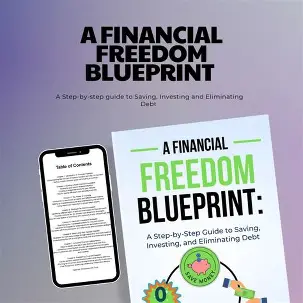
Financial Freedom Blueprint: From Saving to Investing.
Financial freedom isn’t just about having more money—it’s about having control over your money so you can live life on your own terms. Whether that means retiring early, traveling the world, or simply not stressing over bills, the journey begins with a clear plan. The secret lies in moving from saving to investing—turning hard-earned money into a tool that works for you.
This blueprint will walk you through the essential steps to achieving long-term financial independence.
Step 1: Build a Strong Foundation with Saving
Before you can invest, you need a financial cushion. Saving is the first step toward security.
✅ Create an Emergency Fund
- Save at least 3–6 months of living expenses.
- Keep it in a high-yield savings account for easy access.
✅ Budget Wisely
- Track your income and expenses with tools like Mint or YNAB.
- Apply the 50/30/20 rule: 50% for needs, 30% for wants, 20% for savings/investing.
✅ Eliminate High-Interest Debt
Paying down debt—especially credit cards—should come before heavy investing. Debt eats away at future wealth.
Step 2: Shift from Saving to Investing
Once your financial safety net is in place, it’s time to make your money grow.
✅ Start Small, Start Early
Even $100 invested monthly can compound into thousands over time thanks to the power of compound interest.
✅ Explore Investment Options
- Stock Market: Long-term growth potential through stocks and ETFs.
- Mutual Funds & Index Funds: Diversified, lower-risk entry points.
- Real Estate: A tangible asset that generates rental income and appreciation.
- Bonds: Lower risk, steady returns for balance.
✅ Use Tax-Advantaged Accounts
- Contribute to retirement accounts (IRA, 401(k), or their equivalents in your country).
- Take advantage of employer matching if available.
Step 3: Build a Wealth-Building Mindset
Financial freedom is as much about discipline as it is about dollars.
- Consistency Over Perfection: Regular contributions matter more than market timing.
- Long-Term Focus: Avoid panic selling during downturns—history shows markets recover.
- Continuous Learning: Stay informed about personal finance, investing strategies, and economic trends.
Step 4: Automate & Diversify
- Automate Investments: Set up recurring deposits into your brokerage account.
- Diversify Portfolio: Spread investments across sectors and asset classes to reduce risk.
- Rebalance Annually: Adjust your portfolio to match your goals and risk tolerance.
Final Thoughts
The path to financial freedom doesn’t happen overnight—but with the right blueprint, it’s absolutely achievable. Start by saving, then graduate to investing, and finally build a system that compounds wealth over time.
Every dollar you save and invest today brings you closer to a life where money works for you—not the other way around.
✅ Pro Tip: Don’t wait for the “perfect time” to invest. The best time to start was yesterday. The second-best time is today.
